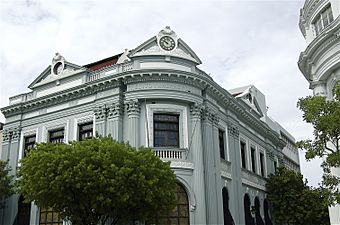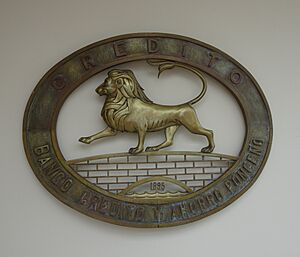Banco Crédito y Ahorro Ponceño (building) facts for kids
Quick facts for kids |
|
|
Banco Crédito y Ahorro Ponceño
|
|

The Banco Crédito y Ahorro Ponceño building on Plaza Degetau
|
|
| Location | Plaza Degetau Ponce, Puerto Rico |
|---|---|
| Area | less than one acre |
| Built | 1924 |
| Architect | Francisco Porrata-Doria |
| Architectural style | Beaux-Arts |
| NRHP reference No. | 87001002 |
| Added to NRHP | June 25, 1987 |
The Banco Crédito y Ahorro Ponceño building is a famous old building in Ponce, Puerto Rico. People often call it Banco Crédito for short. It used to be the main office for a very important bank called Banco Crédito y Ahorro Ponceño (which means Ponce Credit and Savings Bank). This building shows a special old style of architecture from the early 1900s. It was built in 1924. On June 25, 1987, it was added to the U.S. National Register of Historic Places. This means it's a really important historical place. The bank that owned it was one of the biggest in Puerto Rico for most of the 1900s.
Contents
Where is the Banco Crédito Building Located?
The building is on Calle Marina (Marina Street). It is also on Calle Amor (Amor Street). This street is now called "Paseo Arias." The building faces west towards Plaza Degetau, a main square. On its east side is Calle Mayor (Mayor Street). Calle Amor was once known as Callejon Amor, or Love Alley. In 1991, Amor Street became a walking area. It was renamed Paseo Antonio S. Arias Ventura. This was to honor a long-time employee of the bank. He started as a cleaner and became the bank's general manager.
Why is the Banco Crédito Building Important?

The Banco Crédito building was built in 1924. It was the main office for the growing Banco Crédito y Ahorro Ponceño bank. This building is one of the last examples of a popular old building style. This style was common in Ponce after the 1918 San Fermín earthquake.
Who Designed the Banco Crédito Building?
Francisco Porrata-Doria designed and built Banco Crédito. He had just returned to Puerto Rico after studying engineering. He also took architecture classes in the United States. Porrata-Doria was one of the best architects on the island. He helped create modern architecture in Puerto Rico. He also designed many important buildings in Ponce. The Banco Crédito building is a great example of his work.
What Was the Bank's Role?
Many important people from Ponce and Puerto Rico were leaders at this bank. One was Ulpiano Colóm, a former mayor of Ponce. This building, along with the Banco de Ponce next door, shows how local banks tried to compete. They wanted to be as successful as big banks from the U.S. Puerto Rico's sugar economy was growing fast.
The grand design of the Banco Crédito building shows the bank's pride. It also shows how strong and stable the bank was. It could stand up against much richer banks from the United States. These U.S. banks were also trying to get money from wealthy people in Puerto Rico.
How Does the Building Fit in Ponce?
The Banco Crédito y Ahorro Ponceño building is on the city's main square. This makes the area look very elegant. Several buildings nearby are also listed as historic places. These include the old Firehouse (built in 1883). The City Hall (built in 1845) is also nearby. And so is the Cathedral (built in 1841). The front of the Cathedral was also designed by Porrata-Doria in 1932.
What Does the Banco Crédito Building Look Like?
The architect of the building was Francisco Porrata-Doria. It is a two-story building made of masonry (like brick or stone) and concrete. It is located near the southeast end of Ponce's main square. The building is on a corner lot. It faces southwest towards the main street, Plaza Degetau.
Key Architectural Features
The building has a single, solid shape. It curves dramatically around the corner. This curved corner was required by city rules since the late 1800s. The two main floors have very high ceilings, almost twenty feet tall. This makes the building look very big and stand out.
Tall, decorative columns called Corinthian pilasters make the building look even taller. These columns are square and in pairs on the sides facing the streets. On the curved corner, there is one round column.
The outside of the building has three main parts:
- The bottom part is a base made of pink limestone. This type of stone is common in the area.
- The middle part has the tall columns. These columns frame the windows on the two main floors. There are three window sections, with extra single window sections on the longer Amor Street side.
- The top part is very detailed. It has decorations like garlands (like carved wreaths) and dentils (small block shapes). There is also a projecting upper ledge supported by brackets.
On top of the building, there is a railing with balusters (small posts). This railing fills the space between three broken pediments (triangular shapes). The pediment on the corner is curved. The ones on the street sides have stained glass designs in their centers. The one on the corner has a clock.
The windows on the first floor are arched. The windows on the second floor are rectangular. The first-floor windows have decorative cast iron cages. The second-floor windows have balusters. The entire building is topped with a copper roof shaped like a Mansard roof.
Experts from the Puerto Rico Historic Preservation Office say the Banco Crédito building is a great example of the Beaux-Arts style. This style was very popular in Ponce in the early 1900s.
What is the Building Used for Today?
Today, the building is a branch of Banco de Santander. This is a Spanish bank. Banco de Santander bought the assets of Banco Crédito y Ahorro Ponceño in the late 1970s.


